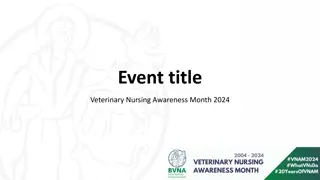Understanding Microscopy and Micrometry in Veterinary Microbiology
Microscopy and micrometry play a crucial role in observing small organisms like microorganisms, making them visible for study. This article delves into the history, definition, types of microscopes, variables used in microscopy, and the significance of these tools in veterinary microbiology.
Download Presentation

Please find below an Image/Link to download the presentation.
The content on the website is provided AS IS for your information and personal use only. It may not be sold, licensed, or shared on other websites without obtaining consent from the author. Download presentation by click this link. If you encounter any issues during the download, it is possible that the publisher has removed the file from their server.
E N D
Presentation Transcript
MICROSCOPY AND MICROMETRY Dr. Sudha Kumari Assistant Professor Department of Veterinary Microbiology Bihar Animal Sciences University, Patna
INTRODUCTION HISTORY BACKGROUND DEFINITION COMPOUND MICROSCOPE - Structure and Function VARIBLES USED IN MICROSCOPY TYPES OF MICROSCOPES USE OF MICROSCOPE CARE OF MICROSCOPE
INTRODUCTION Microscope is a precision instrument which provides magnification so that it enables us to see an object and its structure otherwise invisible to the naked eye. Generally the microorganisms are smaller than this and thus a microscope is essential for their observation.
DEFINITION A microscope ( Greek : micron = small and scopes = aim) MICROSCOPE - An instrument for viewing objects that are too small to be seen by the naked or unaided eye. MICROSCOPY - The science of investigating small objects using such an instrument is called microscopy. OR Micrometry is the measurement of microscopic objects (microorganisms). HISTORICAL BACKGROUND 1590 - Hans Janssen and his son Zacharias Janssen, developed first microscope. 1609 - Galileo Galilei - occhiolino or compound microscope.
1620- Christian Huygens, another Dutchman, developed a simple 2-lens ocular system that was chromatically corrected. Anton van Leeuwenhoek (1632-1723) Anton van Leeuwenhoek is generally credited with bringing the microscope to the attention of biologists. A tradesman of Delft, Holland. 1661 - He discovered bacteria, free-living and parasitic microscopic protests', sperm cells, blood cells, microscopic nematodes etc. Microscope used by Anton von Leeuwenhoek An old pocket Microscope.
VARIABLES USED IN Microscopy MAGNIFICATION Degree of enlargement No. of times the length, breadth or diameter, of an object is multiplied. RESOLUTION Ability to reveal closely adjacent structural details as separate and distinct. LIMIT OF RESOLUTION (LR) The min distance between two visible bodies at which they can be seen as separate and not in contact with each other.
TYPES OF MICROSCOPE:- Simple microscope Compound microscope Phase Contrast Microscope Dark Ground Microscope Fluorescent Microscope Electron Microscope Others
Parts of microscope Illuminator - This is the light source located below the specimen. Condenser - Focuses the ray of light through the specimen. Stage - The fixed stage is a horizontal platform that holds the specimen. Objective - The lens that is directly above the stage. Nosepiece - The portion of the body that holds the objectives over the stage. Iris diaphragm - Regulates the amount of light into the condenser. Base Base supports the microscope which is horseshoe shaped.
Coarse focusing knob - Used to make relatively wide focusing adjustments to the microscope. Fine focusing knob - Used to make relatively small adjustments to the microscope. Body - The microscope body. Ocular eyepiece - Lens on the top of the body tube. It has a magnification of 10 normal vision.
OBJECTIVE LENS Mounted on nose piece It forms magnified real image. Magnification of objective = Optical Tube length Focal Length Types 1. Scan - 4X , 2. Low Power 10X 3. High Power - 40X , 4. Oil immersion - 100X
OIL IMMERSION OBJECTIVE Highest magnification Oil prevents refraction of light outwards and allows it to pass straight in to objective. USING COMPOUND MICROSCOPE Grasp the microscopes arm with one hand and place your other hand under the base . Place the microscope on a bench. Adjust seat. Clean Lenses. Turn the coarse adjustment knob to raise the body tube arm.
Revolve the nose piece to set low-power objective lens. Adjust the Condenser lenses and diaphragm. Place a slide on the stage and secure with stage clips. Switch on the light at low intensity and then increase intensity. Turn the coarse adjustment knob to lower the body tube until the low power objective reaches its lowest point. Looking through the eyepiece, very slowly move the coarse adjustment knob until the specimen comes into focus. Adjust distance between eye piece.
Switch to the high power objective lens only after adjusting condenser and iris diaphragm. Place a drop of oil over specimen before using oil immersion objective. Lower the objective until oil makes contact with objective. Looking through the eyepiece, very slowly focus the objective away from the slide.























